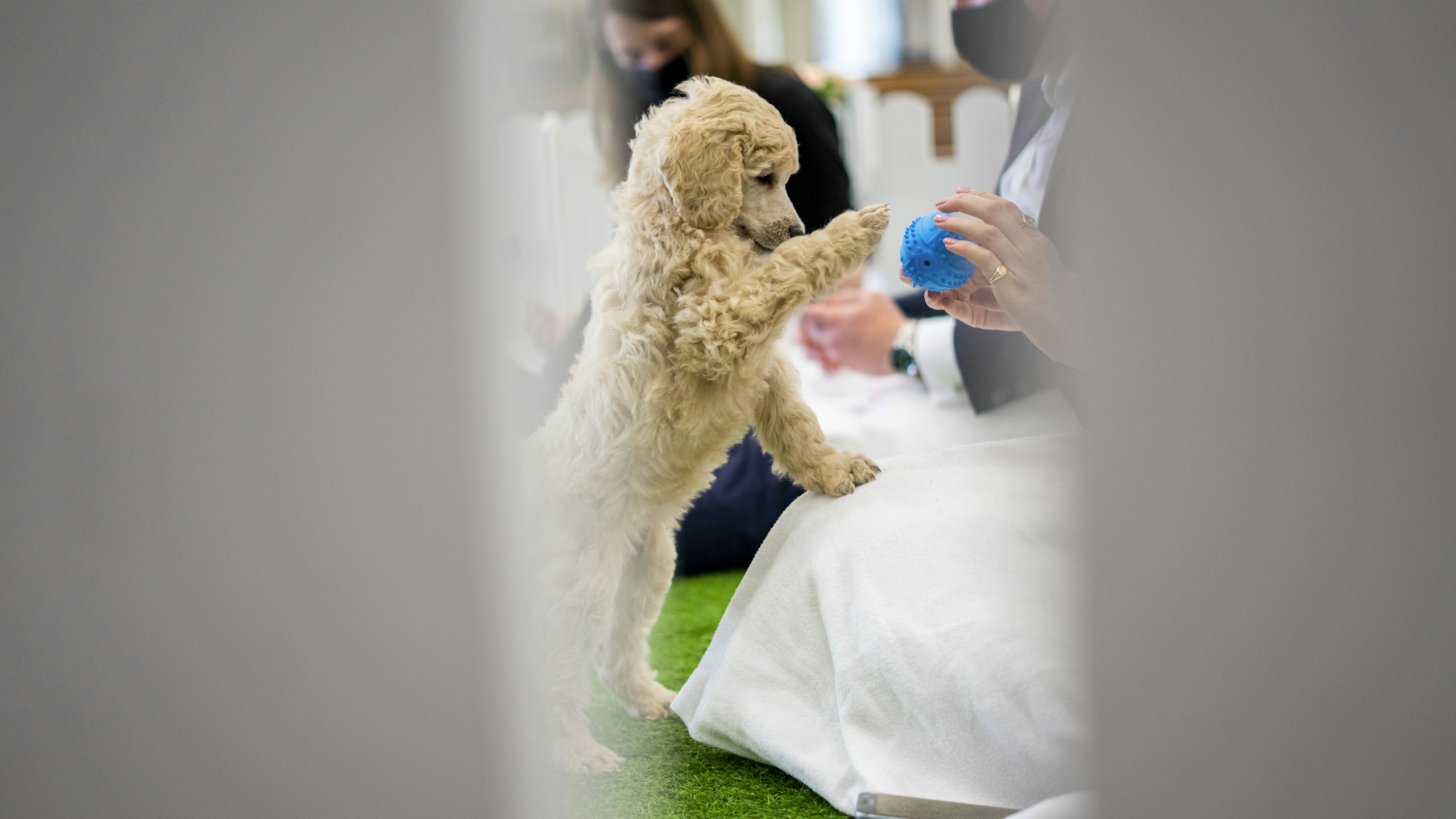How much should you exercise your puppy?
It’s an extremely exciting time when you bring a pup home, but there’s a lot of preparation to do before their arrival! Exercise is something to consider, on top of training, feeding, and grooming; have you thought about how much exercise your pup needs? Read on to find out!

By Emily Roach, Paws in Work guest blogger.
Is it breed-specific?
There’s a general guideline of 5 minutes per month of age x2 per day for all puppies to go by. For example, if your puppy is 3 months old, their exercise allowance is x2 15-minute sessions per day. Alternatively, you could do one 30-minute session of gentle exercise but ask your vet what is best for your pup’s development. You should also consider breed characteristics; brachycephalic breeds such as bulldogs and pugs aren’t able to regulate their temperature as well as others. This can become a hazard when exercising, particularly in the summer months.
It’s important not to overdo it whilst your puppy is still developing. Larger breeds take longer to fully develop compared to smaller breeds who are usually fully grown from 6 months – 1 year of age. Great Danes, for example, can take up to 2 years to reach their full size! It’s important to bear this in mind when it comes to exercising your pup.
On and off lead.
It’s advised to get your pup used to wearing a collar and lead as quickly as possible. Don’t be surprised if they try to play a game of chewing the lead every time you move; they’ll grow out of this! Taking your pup for a walk around the block (once vaccinated) is the perfect way to incorporate exercise whilst socialising them. As previously mentioned, it’s recommended to stick to the 5-minute rule to prevent over-exerting your puppy.
A great way of exercising your pup off-lead is by playing with them at home with a variety of fun toys to keep them stimulated. As your pup gets older, you can take them to safe open areas for a fun game of fetch. It’s always a good idea to make sure your pup is exercised before you attempt to leave them alone, even if it’s for a short amount of time. This gives them the opportunity to let out their energy which could be translated into separation anxiety if they’re not sleepy enough.
Should you vary the exercise?
Initially, your puppy will spend most of their day sleeping and producing all-important growth hormones. As time goes by, it’s a good idea to switch things up when exercising your puppy. You could do this by introducing new toys to play with. Try not to have too many toys available at one time as your pup can become bored of them and may resort to chewing up your sofa instead!
Aim to introduce your puppy to new walking routes as they become more confident, such as walking around the block, down the high street or in the woods! This will keep things exciting for your pup and is good for their mental stimulation too.
How much is too much?
As previously mentioned, there’s a general guideline for owners to follow when bringing their pups home, but certain breed characteristics can influence this. You don’t want to over-exercise your puppy, as this could interfere with their crucial periods of growth, leading to potential health problems in the future.
Speaking to your pup’s breeder to find out their specific needs is a great starting point. You should also contact your veterinarian on how much exercise they advise as your pup grows. You should also look for behavioural signals in your pup that will indicate they’ve had enough exercise such as:
- Excessive panting
- Laying down during exercise
- Disengaging in play
- Loss of focus / not responding to commands
To summarise:
- Stick to the 5-minute rule when first bringing your pup home
- Switch between on and off-lead exercise
- Speak to the breeder / your vet about your pup’s specific needs and future exercise
- Keep things interesting– it’s important to keep them mentally stimulated as well as physically stimulated!
- Read your pup’s body language which may indicate over-exertion – let them relax
Subscribe to our newsletter.
Want to keep up with our latest tips, event news and blogs? If so, you can join the pack by subscribing to our bi-weekly newsletter! Click here.

Why Licensing Matters in Puppy Therapy: What You Need to Know
Puppy therapy is booming in UK workplaces, but not every provider plays by the rules. At Paws in Work, we explain why licensing is key to safety, welfare, and trust. Learn how to spot licensed providers and protect puppy wellbeing.

A Guide to Puppy Vaccinations: When, Why & How?
In this blog, we’ve covered when to vaccinate puppies, what the vaccines protect against, and why our Paws in Work events stay super safe even if pups haven’t completed their full vaccination schedule yet. We’ve got everything covered so you can relax, enjoy the snuggles, and know every wagging tail is in safe hands.

Puppy Welfare at Paws in Work
Puppy welfare at Paws in Work is, and will always be, at the heart of the business. Every puppy that joins our socialisation programme or participates in our puppy therapy events comes from ethical, reputable breeder partners. Read our blog to find out more.
